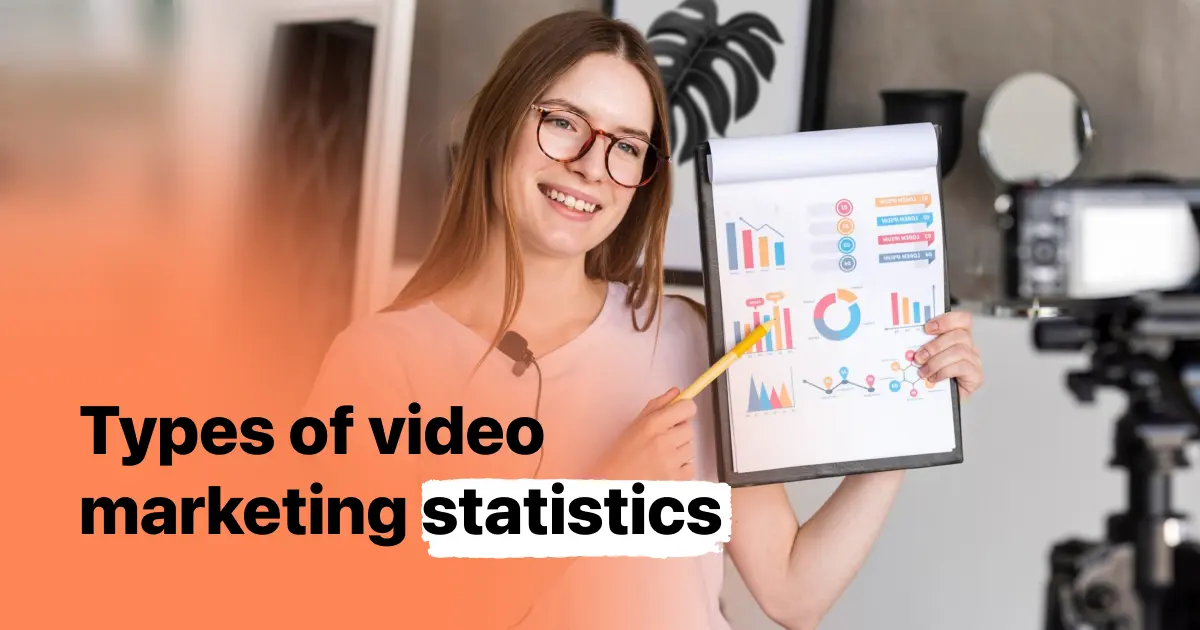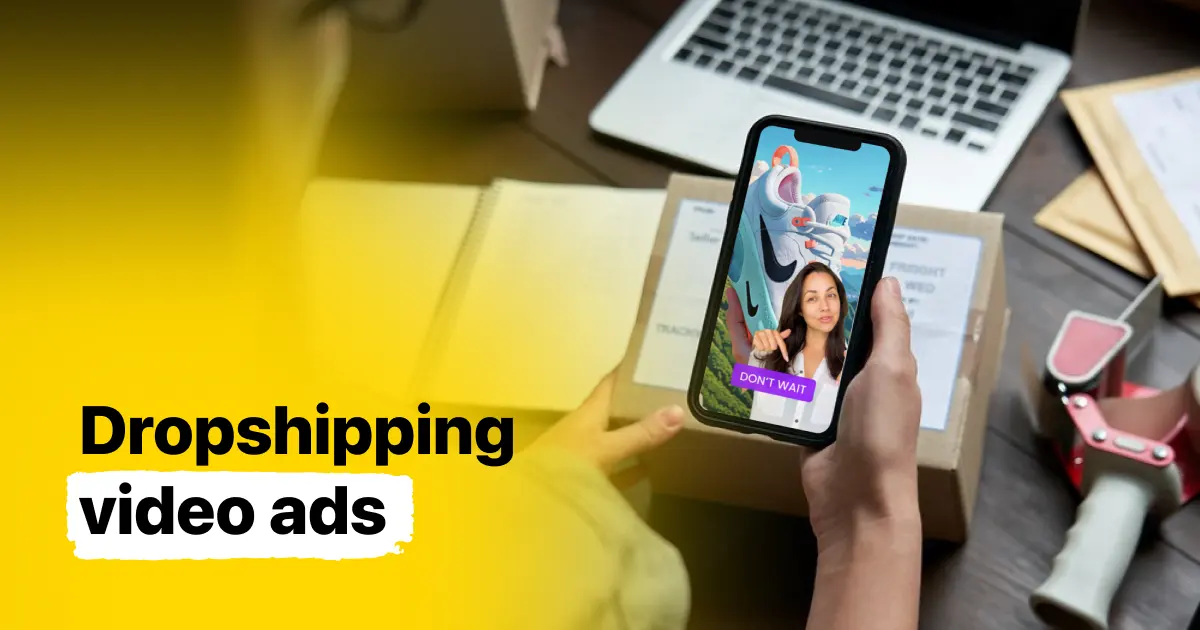Plans built for businesses
Pro + AI
For pro video creation
Advanced + AI
For users who want to generate video ads
*Billed yearly
Compare plans
22 Video Marketing Statistics Shaping 2024
28 July, 2024
It is crucial to stay updated with the latest trends and statistics in the dynamic world of digital marketing in order to make informed decisions. Video marketing continues to dominate as a powerful tool for engaging audiences and driving conversions.
The following video marketing statistics highlight the trends shaping 2024 and provide insights into the opportunities they create for marketers. Additionally, we'll explore how AI, specifically Zoomerang AI, is revolutionizing video marketing.
Statistic 1: Video Content Will Make Up 82% of All Online Traffic
By 2024, it’s projected that video content will constitute 82% of all online traffic (Cisco). This overwhelming dominance emphasizes the importance of integrating video into your marketing strategy.
What It Means
The growing preference for video content means that businesses must prioritize video marketing to capture audience attention and stay competitive.
Opportunities
Marketers can capitalize on this trend by creating diverse video content, such as tutorials, product demos, and live streams, to engage and convert their audience.
Statistic 2: 87% of Video Marketers Report Positive ROI
According to a survey, 87% of video marketers report that video gives them a positive ROI (Wyzowl). This high ROI highlights video marketing's effectiveness in driving sales and customer engagement.
What It Means
Investing in video marketing is likely to yield significant returns, making it a wise allocation of marketing budgets.
Opportunities
Businesses can optimize their ROI by producing high-quality, targeted video content that resonates with their audience and addresses their needs.
Statistic 3: 96% of Consumers Have Watched an Explainer Video
A staggering 96% of consumers have watched an explainer video to learn more about a product or service (Wyzowl). Explainer videos are crucial for educating potential customers and influencing their purchase decisions.
What It Means
Explainer videos are a vital tool for conveying complex information in an engaging and easily digestible format.
Opportunities
Marketers should focus on creating clear, concise explainer videos to effectively communicate their value propositions and drive conversions.
Statistic 4: 73% of Consumers Prefer to Watch a Short Video
73% of consumers prefer to learn about a product or service by watching a short video (HubSpot). This preference underscores the power of concise, impactful video content.
What It Means
Short videos are more likely to capture and retain viewers' attention, making them an essential component of any marketing strategy.
Opportunities
Marketers can leverage short videos for social media, product launches, and advertisements to quickly convey key messages and engage their audience.
Statistic 5: 88% of Marketers Are Satisfied with Their Video Marketing ROI
88% of marketers are satisfied with the ROI of their video marketing efforts (Animoto). This satisfaction reflects video marketing’s effectiveness in achieving business goals.
What It Means
High satisfaction levels among marketers indicate that video marketing strategies are generally successful and worth investing in.
Opportunities
Businesses should continually refine their video marketing strategies to maintain high satisfaction levels and maximize ROI.
Statistic 6: Video Ads Have an Average Click-Through Rate of 1.84%
The average click-through rate (CTR) for video ads is 1.84% (Smart Insights). This is higher than many other forms of digital advertising, demonstrating video ads' effectiveness.
What It Means
Video ads are highly engaging and effective at driving traffic to websites and landing pages.
Opportunities
Marketers can use video ads to boost their online advertising campaigns, leveraging the higher CTR to increase conversions.
Statistic 7: 54% of Consumers Want to See More Video Content from Brands
54% of consumers want to see more video content from the brands they support (HubSpot). This demand highlights the need for brands to produce more video content.
What It Means
Consumers’ preference for video content indicates a significant opportunity for brands to increase engagement and loyalty.
Opportunities
Brands can meet this demand by consistently producing high-quality video content that aligns with their audience's interests and preferences.
Statistic 8: Video on Landing Pages Can Increase Conversions by 80%
Including a video on a landing page can increase conversions by up to 80% (Unbounce). This significant boost underscores the power of video in driving customer actions.
What It Means
Videos can enhance the effectiveness of landing pages by providing compelling, visual explanations of products or services.
Opportunities
Marketers should incorporate videos into their landing pages to increase engagement and drive higher conversion rates.
Statistic 9: 85% of Facebook Videos Are Watched Without Sound
85% of Facebook videos are watched without sound (Digiday). This statistic emphasizes the importance of optimizing videos for silent viewing.
What It Means
Videos must be designed to convey their message effectively even without sound, using captions and visual storytelling.
Opportunities
Marketers can ensure their videos are accessible and engaging without sound by incorporating clear visuals, text overlays, and captions.
Statistic 10: 64% of Consumers Make a Purchase After Watching Branded Social Videos
64% of consumers make a purchase after watching branded social videos (Tubular Insights). This conversion rate highlights the direct impact of video marketing on sales.
What It Means
Branded social videos are effective at driving consumer purchases, making them a valuable tool for e-commerce and retail businesses.
Opportunities
Marketers can create compelling branded videos to drive consumer purchase decisions and boost sales.
Statistic 11: YouTube Reaches More 18-49-Year-Olds Than Any Cable Network
YouTube reaches more 18-49-year-olds than any cable network in the U.S. (Google). This reach makes YouTube an essential platform for targeting this key demographic.
What It Means
YouTube's extensive reach among younger audiences makes it a critical platform for video marketing.
Opportunities
Businesses should leverage YouTube to reach and engage with the 18-49 demographic, creating content that resonates with this audience.
Statistic 12: Viewers Retain 95% of a Message When Watched in a Video
Viewers retain 95% of a message when they watch it in a video compared to 10% when reading it in text (Insivia). This high retention rate underscores the effectiveness of video in communication.
What It Means
Video is a highly effective medium for conveying messages and ensuring they are remembered.
Opportunities
Marketers can use video to effectively communicate key messages, enhancing audience retention and understanding.
Statistic 13: 74% of Marketers Say Video Has a Better ROI Than Static Imagery
74% of marketers believe video has a better ROI than static imagery (Animoto). This belief underscores the value of investing in video content over static images.
What It Means
Video content is more effective at generating returns than static imagery, making it a preferred choice for marketers.
Opportunities
Businesses should prioritize video content in their marketing strategies to maximize ROI and engagement.
Statistic 14: 85% of Businesses Use Video as a Marketing Tool
85% of businesses use video as a marketing tool (Wyzowl). This widespread adoption highlights the importance of video in modern marketing strategies.
What It Means
The prevalence of video marketing underscores its effectiveness and necessity in reaching and engaging audiences.
Opportunities
Businesses not yet utilizing video marketing should consider integrating it into their strategies to stay competitive.
Statistic 15: 81% of People Have Been Convinced to Buy a Product or Service by Watching a Brand's Video
81% of people have been convinced to buy a product or service by watching a brand's video (Wyzowl). This statistic underscores the persuasive power of video marketing.
What It Means
Video content is highly persuasive, making it a powerful tool for driving sales and conversions.
Opportunities
Marketers should create compelling video content that effectively showcases their products or services to drive purchase decisions.
Statistic 16: 59% of Executives Prefer Video Over Text
59% of executives prefer watching a video over reading text if both are available on the same topic (Forbes). This preference highlights the importance of video in B2B marketing.
What It Means
Video content is effective in reaching and engaging executive audiences, making it a valuable tool for B2B marketing.
Opportunities
Businesses can use video to communicate effectively with executive audiences, presenting information in a format that aligns with their preferences.
Statistic 17: AI is Expected to Drive a 30% Increase in Video Marketing Efficiency
AI technology is expected to drive a 30% increase in video marketing efficiency (McKinsey). This efficiency gain highlights the transformative impact of AI on video marketing.
What It Means
AI can streamline video production and optimize marketing strategies, making video marketing more efficient and effective.
Opportunities
Marketers can leverage AI tools like Zoomerang AI to create high-quality video content quickly and efficiently, maximizing their marketing efforts.
Statistic 18: 70% of Marketers Plan to Use AI in Video Marketing
70% of marketers plan to use AI in their video marketing strategies by the end of 2024 (Gartner). This adoption rate underscores the growing role of AI in video marketing.
What It Means
AI is becoming an integral part of video marketing, providing advanced capabilities for content creation and optimization.
Opportunities
Businesses can stay ahead of the curve by integrating AI into their video marketing strategies, using tools like Zoomerang AI to enhance their video content.
Statistic 19: Zoomerang AI Users Report a 50% Reduction in Video Production Time
Users of Zoomerang AI report a 50% reduction in video production time (Zoomerang AI). This efficiency gain demonstrates the tool’s effectiveness in streamlining video creation.
What It Means
Zoomerang AI significantly reduces the time required to produce high-quality video content, allowing marketers to be more agile and responsive.
Opportunities
Marketers can use Zoomerang AI to accelerate their video production processes, enabling them to create and deploy video content more rapidly.
Statistic 20: Video Consumption on Mobile Devices Increases by 100% Every Year
Video consumption on mobile devices has been increasing by 100% every year (Insivia). This trend highlights the growing importance of mobile-friendly video content.
What It Means
Mobile devices are becoming the primary platform for video consumption, necessitating mobile-optimized video content.
Opportunities
Marketers should ensure their video content is optimized for mobile viewing, focusing on short, engaging formats that perform well on smaller screens.
Statistic 21: 85% of Internet Users in the U.S. Watch Online Video Content Monthly
85% of internet users in the U.S. watch online video content monthly (Statista). This statistic highlights the widespread consumption of video content among internet users.
What It Means
A large majority of internet users regularly engage with video content, indicating its integral role in online behavior.
Opportunities
Marketers can reach a vast audience by producing and distributing video content, ensuring they capture the attention of a broad demographic.
Statistic 22: Video Viewers Are 1.7 Times More Likely to Purchase a Product Than Non-Viewers
Video viewers are 1.7 times more likely to purchase a product than non-viewers (HubSpot). This higher likelihood of purchase underscores the persuasive power of video content.
What It Means
Video content significantly influences purchasing decisions, making it a critical component of any effective marketing strategy.
Opportunities
Businesses can boost their sales by creating persuasive video content that highlights the benefits and features of their products, compelling viewers to make a purchase.
Conclusion
The video marketing statistics shaping 2024 underscore the growing dominance and effectiveness of video content in engaging audiences and driving business results.
With advancements in AI technology, tools like Zoomerang AI are making it easier and more efficient for marketers to produce high-quality video content.
By staying informed about these trends and leveraging the power of AI, businesses can maximize the impact of their video marketing efforts and achieve their goals.








